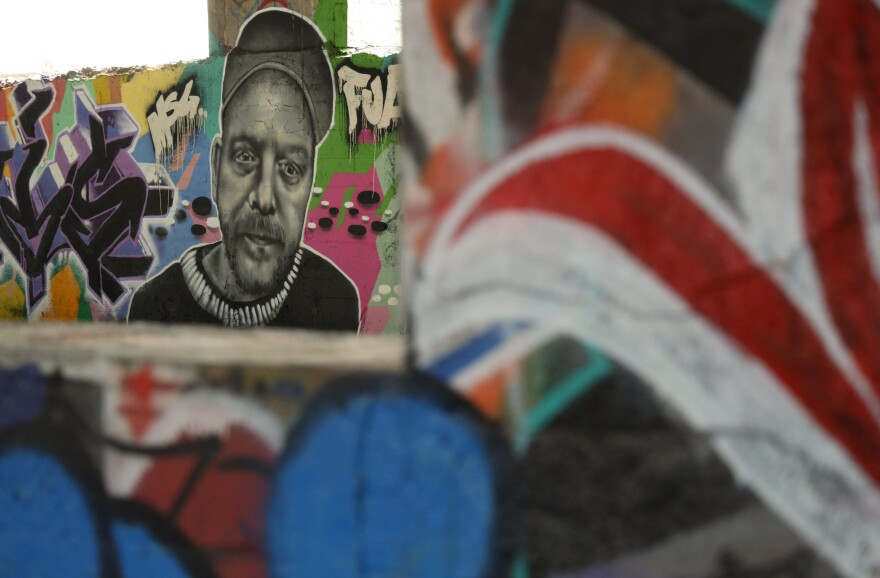As officials work to revitalize Rochester, an explosion of spray paint across the city is seen as furthering — and undercutting — its revival.
“There was an uptick in graffiti that started during the pandemic," said Rich Perrin, the city's environmental services commissioner. "And it's been nationwide."
Up north, a town in British Columbia, Canada, is banning the sale of spray paint to minors in an effort to tamp down the vandalism. No such measures are being considered locally, but the city's Defacer Eraser crew is being kept busy. And the state, for the first time, is enlisting added help to clear the graffiti accumulating along interstate highways, specifically in the Rochester region.

“There's a difference between art and vandalism," said Perrin, who in overseeing the city's streets, parks and public works sees a lot of graffiti. "Artists don't, you know, just put their name on bridge abutments, or the backs of buildings.”
Some of them do.
But from City Hall's perspective, it's about care and upkeep.
Perrin continued: “Anytime we improve the physical environment of the city, the way it looks, the way it feels, then that has benefits not only to quality of life, but also economic development.”
Still, the painted landscape has a role to play there, too.
Rochester’s graffiti scene is nationally if not internationally known — with a distinct, gnarled style that evolved through generations.
Unlike some cities where graffiti and gangs are intertwined, here the two have more of an adversarial relationship. That is to say, the increase in graffiti is not tied to the increase in violence the city is seeing.
Nowhere is the breadth of artistry more evident than downtown, in the abandoned subway and historic aqueduct, a cavernous space beneath the Broad Street bridge that is uniquely Rochester.

'Never meant to be glorified'
The history here is as layered as the graffiti that fills its walls.
As graffiti and street art have become more celebrated and mainstream, the subway has become a showcase. Among the first to paint here is an artist known as Range, now 48, with a family. There are times he marvels at the evolution of public acceptance.
"A lot of folks don't understand the differences between 'street art' and graffiti," he said. "Street art has become an acceptable form of art. Somehow graffiti was kind of put under that same umbrella ... (but) graffiti and tagging, you know, was never meant to be glorified by the community."
Yet the ever-changing underground graffiti gallery draws visitors from around the world to see it, photograph it, paint it.
And, in recent weeks, a group of suburban teenagers to deface it – with profane and inane scribbles.
"I've been painting in the subway since 1992, right?" said Range, who has been one of the city's most prolific graffiti artists and is the leader of its oldest graffiti crew, FUA. "So now we got a bunch of younger kids, and other people. And just because it isn't as wild as it was in the '90s doesn't mean that those rules don't apply."
Those rules are unwritten, but define what gets painted, where it gets painted, and who gets to do it. Still, graffiti by nature is an ephemeral art form. And graffiti writers and artists are hesitant to call out someone for picking up a spray paint can.
"Basically everything that I had down here (in the subway) was destroyed," said a graffiti artist who goes by Manta. "It hurts. It feels personal sometimes. ... But also, they're going over every artist that they can find."

The artists are being identified only by tag names because the painting they do blurs the line between unsanctioned — but allowed — in places like the subway, and illegal out in the community.
'The beauty of it'
Manta is a relative newcomer at 18, and one of only a handful of women among dozens of men who are actively painting. The subway got her hooked, she said. The pandemic gave her time to develop her technique.

"The subway has always been one of those spaces where artists will come make beautiful walls, and then somebody will come and scribble over it," she said. "And it's been like that since people started painting here. ... And that's a big part of the beauty of it."
Plans to tear off the bridge and redevelop this space into a public gathering spot and riverway centerpiece include an effort to preserve something of this space.
Manta's mother, Jessica Lieberman, is part of that effort. Lieberman teaches at RIT, is something of an expert in Rochester graffiti and is working with the city to better understand the local graffiti scene.
"This is what I'm fighting to save. This is my everything," Lieberman said one afternoon, standing in the old subway, pointing to a colorful piece depicting the artists' names over water.
The artists were Nova and the late and revered Bones.
"When (this structure) was abandoned and unused," Lieberman said of the subway, "they were here celebrating it."
Though looking to the future, and eventual reuse of the aqueduct, Perrin said the city is intent on not losing its past.
“We're re-telling the history of that structure — as a canal, as a subway bed, as a roadway," he said. "But it's also a place for art for muralism. So we are very active in ensuring that we take into account that culture and maintain it. Because that is art.
"It is unique to Rochester, and it It's part of our sense of place."
It’s also part of the city’s very fabric. Because graffiti in whatever form is subversive speech. And that is embedded in Rochester’s history.

"Graffiti is about putting your name out there in spaces that other people own, but where you live, and you act, and you reside — but you have no ownership,” Lieberman said. "So it's so connected to marginalized populations, weighing in on civic discourse, and doing it in this way.
"Which is why you can't only support the arts, you also kind of have to support some of the vandalism. Because often that is crying out, calling out, you know, being heard.”
Clamber up on the graffiti-covered ledge of the subway and you can look out, upriver, toward Court Street, Interstate 490 and the arched bridge named for Frederick Douglass and Susan B. Anthony — who called out in a different time and place, wanting to be heard.



